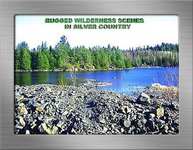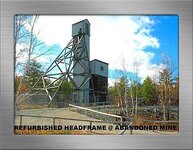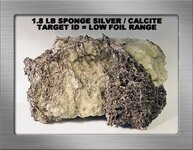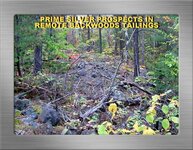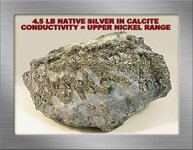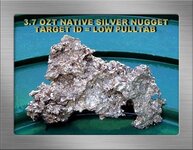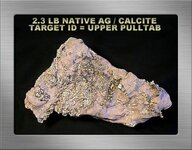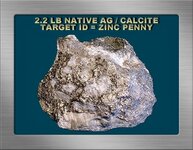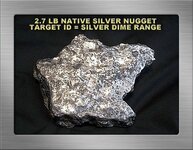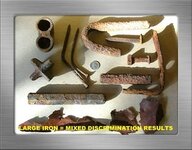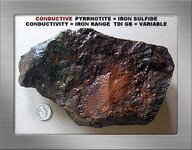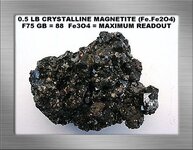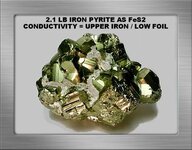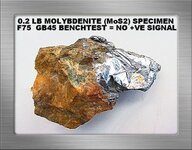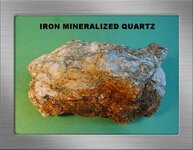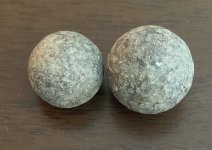Jim Hemmingway
Hero Member
- Jan 26, 2008
- 789
- 1,615
- Detector(s) used
- F-75, Infinium LS, MXT, GoldBug2, TDI Pro, 1280X Aquanaut, Garrett ProPointer
- Primary Interest:
- Prospecting
The F75 in Silver Country
Introduction
Electronic prospecting for silver ores and nuggets as described below is a wonderful hobby that has attracted many thousands of participants from across the continent over several decades. If we set forth to search for silver, it is best to view it as an outing to enjoy the great outdoors… and with some patience and minor effort… perhaps locate a few attractive silver specimens. I recently returned from a visit to silver country here in Ontario where there was ample opportunity to evaluate the electronic prospecting capabilities of an F-75 metal detector.
The native silver ores and nuggets found here share a similar conductive range to gold, but we encounter greater numbers of higher conductive silver up to and including the silver dime category for all practicality. The majority of silver ores tend to reside within a category from foil to pulltab range. The similarity to gold results from factors such as purity, type of mineral inclusions, size, shape, structure and so forth. Native silver here can generally range up to 95% purity but is associated with a number of minerals common to the area. Those normally encountered by electronic prospectors include safflorite, cobaltite, niccolite, skutterudite and many other substances that may or not be detectable in the field but nonetheless frequently co-inhabit the same rocks as detectable native silver.
Searching for native silver ores with the F75 is a unique application of this detector and it excels at the task. It is ore evaluation capable in the field thanks to a full range, manually adjustable, visually calibrated ground balance scale used in concert with a highly sensitive stat / true non-motion all metal mode. The F75 equipped with the stock 11” DD coil is superb at separating silver from ferrous trash, and has excellent depth potential in all but highly magnetic susceptible ground minerals. The 10” elliptical concentric offers advantages over the stock coil such as improved sensitivity in the all-metal mode, more adept target signal evaluation, and better shallow iron discrimination. For the goldhunters, the 10” elliptical concentric is more sensitive than the stock DD coil to shallow small nuggets whereas either the 5“ round DD or particularly the 6” elliptical concentric coil noticeably improve sensitivity to sub-grain nuggets.
General Searching
Let’s presume our research has been completed on an area where good silver has been found in quantity in the past. We have arrived at a minesite that our information indicates may offer some electronic prospecting potential. Before unlimbering our detectors, let’s spend a moment to assess the site and consider a few search strategies.
We should look around the property and identify the location of former surface ore veins or shafts (mostly fenced-in nowadays in more accessible areas here in Ontario), headframe and storage building areas where we can be confident good silver was retrieved, graded, stored, moved, and sometimes inadvertently misplaced. Below is a photo of a typical headframe… where yesteryear’s miners handled considerable quantities of valuable silver.
Most frame buildings have long since collapsed or been removed, but on-site inspection usually will reveal evidence of former buildings… sometimes in the form of concrete foundations, remnants of building or roofing materials, and an unmistakable proliferation of iron debris.
As a result of misgrading of ores, good silver was occasionally dumped with waste rock on to the waste tailing disposal areas. At some sites the tailings can be 25 to 30 feet high and occupy enormously large tracts and “runs” that snake off into the bush. These mine tailings were used to build local roads, storage beds, minesite entrances, loading ramps, and routes to facilitate waste rock transport from the mine to the tailing disposal areas. All these offer excellent prospects to search with a suitable metal detector.
Both valuable ores and waste rock were transported with wagons, carts and oxen. Occasional breakdowns resulted in spills of high-grade silver. It is very easy to imagine under such primitive conditions and terrain that some rich silver remained right where it fell. The specimen depicted in the photo below was found along with several other attractive samples a few years ago. It was located in an overgrown ditch on the downhill side of a sharp bend in a minesite entranceway… an ideal spot that should always attract an alert electronic prospector’s attention.
As we survey the minesite’s waste tailing landscape, we will observe indications of previous metal detecting and mineral collecting activities. You will doubtless see many dig sites scattered randomly across the flat and other easily accessible areas. To improve our likelihood of locating desirable specimens, we should search areas requiring a bit more effort to access and detect… try to get off the beaten path. Such opportunity exists out on the peripheral areas, down in the gullies, up on the benches, along the face of ridges and slopes, under the trees and bushes, and equally important… do not ignore prospects available in iron-infested trashy areas wherever encountered.
Many detectorists will avoid trashy sites, preferring easier pickings. A suitable unit such as the F-75 that offers superior target separation ability…equipped with a DD or perhaps a sniper size coil… will ferret out good silver from these environs. Detect trashy sites carefully and exercise patience.
The photo below illustrates that an enterprising electronic prospector can improve the odds of locating desirable specimens or nuggets by making an effort to get away from the open flat areas. The less accessible areas under the nearby trees and bushes have been consistently productive for us. Such areas usually prove to be a continuation of existing visible tailings, but over many decades have become hidden from view by forest encroachment.
This above site is located on a now overgrown ridgetop that formerly served as a waste tailing disposal area for a high production mining operation. It recently rewarded me with the handsome native silver specimen as depicted in the photo below. Repetitive searching for many years along the face of the ridge has produced many specimen grade silver finds ranging from a few grams to multiple-pound native silver ores.
The small but handsome native silver nugget depicted in the photo below was one of my first finds using the F-75 this past autumn. It is the specific piece that firmly settled me into a comfort zone using the F75 for this application. It was found by making the effort to get under the trees and low brushy areas for some serious “bushwhacking” while ignoring the discomfort of heat and fending-off the blackflies. You do what it takes to ‘git-er-done’ when pursuing any type of mineral hunting… and that certainly applies to chasing silver ores and nuggets in the rugged boreal forest environs of northeastern Ontario’s Precambrian Shield.
A final suggestion to always keep in mind and follow through on when searching these sites is to not be discouraged by any evidence of past digging in the area you select. Always check any unfilled holes. I was recently surprised that an electronic prospector did not dig just a few inches deeper to retrieve two specimens found in two separate holes within a few yards. These two pieces yielded solid, tight, high conductive signals that could not possibly have been confused with large iron. One such specimen is shown in the photo below and the other example will follow later.
Silver Ore Target Identification
When silver hunting we are searching for more valuable coin-size and larger pieces of silver. Silver purity, types of non-ferrous mineral inclusions, structure [dendritic, plate, disseminated, sponge, massive silver], size, shape, the presence of non-conductive ferromagnetic minerals within specimen structure, and the profile presented to the coil all result in a wide range of target conductivities. Natural silver ores and nuggets will target ID from low foil up to and including a maximum of silver dime range… although there are extremely rare higher conductive samples occasionally found, but most will occupy a conductive range from mid-foil to pulltab inclusive. There are exceptions resulting from variable factors such as ground moisture content, proximity of adjacent ferrous material, strength of non-conductive magnetic susceptible iron minerals, and disturbed ground conditions. These factors can and do result in good silver reading as iron. This is especially prevalent in disturbed ground, such as loose material at the base of slopes, and large areas where tailings have been moved around or otherwise disturbed by mining or municipal authorities.
The F-75 in Rock Country
The F-75 is a deepseeking unit with superb target separation capability. It offers excellent signal response to a wide conductive range and particularly to lower conductives. Its sensitivity to small low conductives exceeds what might be otherwise anticipated from a unit operating at 13kHz. The all-metal autotune and the JE discrimination modes both excel in response to both large and tiny low conductives at very good depth. The unit offers either a calibrated full range, manually adjustable ground balance feature or an optional fast-grab auto ground balance feature that is invoked by using the auto-grab trigger located beneath the target ID meter. The fast-grab feature also serves as a quick, accurate and very convenient tool to evaluate suspect target signals such as non-conductive ferromagnetic positive hotrocks. For more information about hotrocks please review the link below… http://www.treasurenet.com/forums/c...-magnetic-susceptibility-february-2011-a.html.
The unit provides full range target ID digital readouts in all modes, including the motion all-metal mode. It has four separate discrimination modes for coin, jewelry, and relic hunting applications. To compliment the manually adjustable ground balance, a stat or true non-motion all-metal mode is available to perform sensitive ore and mineralized rock benchtest evaluations. The motion all-metal mode’s adjustable threshold, fast threshold autotune rate, and excellent sensitivity to tiny low conductives make it an excellent choice for both general searching and small nugget hunting… and this is our preferred search mode over most conditions.
The JE mode… in concert with the stock 11”DD or preferably the smaller sniper coils… excels at searching for small low conductive targets in trashy tailings. The concept behind using small iron discrimination in the JE mode over trash-abundant areas is that you are better off finding at least some silver rather than spending your time frustrated with chasing after innumerable small blaring iron signals while using a motion all-metal mode. The JE mode is remarkably sensitive and deepseeking despite employing small iron discrimination sufficient to eliminate signals from pesky iron tidbits such as small nails, bootacks, and small bits of wire.
Employing iron tone ID means that any target classified within the iron target ID range will be assigned this low iron tone. It will result directly in the loss of good silver targets that easily target ID as iron in disturbed ground / loose tailings. More, any silver co-located with iron that might result in an iron target ID, will also be lost to the iron tone. Stick with monotone for unbiased signal interpretation unless you are prepared to lose good silver.
And finally, it should be emphasized that the all-metal motion mode is unquestionably deeperseeking than JE mode. But equipped with the stock 11” DD elliptical coil in particular, the JE mode comes very close on half-gram size and larger, deeper silver nuggets and ores despite employing small iron discrimination. Its performance has very real implications for detecting small low conductives in trashy tailings. The photo below depicts my first multi-lb native silver found with the F-75… but frankly an inexpensive coin hunting unit would easily have found it.
The F-75 performed very well over all conditions encountered while hunting in both mine tailings and in the outback while using the stock 11” DD coil with high sensitivity levels. Ground conditions ranged from a ground balance setting in the high GB60s over weathered rocks to the low GB90s (GB scale range = 0 to 99) over diabase and other mafics. Magnetic susceptibility readouts over mine tailings normally range from 0.1% to 0.3% except over diabase where the meter generally reads at 1.0% EM (equivalent magnetite).
Despite nearby hydro wires and transmission towers in close proximity to some sites, electromagnetic interference (EMI) was not an operating issue. The highly sensitive JE mode was occasionally affected by these power sources, but using small iron discrimination levels, and / or invoking small reductions in sensitivity satisfactory resolved any stability issues with little impact on depth performance. If instability becomes an issue at a given site try one or more of the following measures: (a) Increase the discrimination level up to full iron range as a first step, followed by reduced sensitivity settings… but no more than necessary. (b) Use a smaller 6” elliptical concentric or 5” round DD coil. (c) Employ the highly stable all-metal motion mode if trash levels are tolerable. The visual target ID is available in this mode to help with identifying small iron trash, but use it more effectively by removing overburden from suspect signals until confident of the target ID.
In areas that have seen decades of detecting pressure where shallow silver has pretty much been removed, the deepseeking all-metal motion mode is the preferred operating choice as previously noted. It is much more stable than discrimination modes, achieves better EMF penetration in harsher ground minerals than do discrimination modes, and it is significantly less affected by electromagnetic interference. This mode was used adjacent to a nearby transmission tower at one site. The threshold autotune rate was quite sufficient to maintain a smooth background “hum” under these search conditions. It could be operated at maximum sensitivity in most areas, and occasional slight background chatter at some sites was quite acceptable. The photo below shows the second silver specimen left in a partial excavation by a careless electronic prospector.
More About Iron
The F-75 responds to silver ores with a reasonably stable readout and a "tight" audio signal. I was always fairly confident when silver was under the coil… a confidence that was enhanced by the fact that shallow, large iron nearly always produced a more erratic target ID with different sweep directions. In that respect a target ID meter is a real benefit, and I was happy to have it psychologically too. It encouraged digging some target signals in difficult hardpacked rocky substrates that looked promising. This was my first experience with a target ID meter for electronic prospecting and it certainly added some “fun” value to the overall detecting experience.
Target ID and discrimination on large iron in the silverfields was quite different from the results obtained in my “disturbed ground” patio test plot, as would be the case with any other VLF detectors. Most small iron continued to identify and discriminate well within the iron range, but large iron produced good solid signals that would target ID all over the non-ferrous meter scale. These would often reveal their conductive and magnetic nature by producing erratic readouts on elongated iron using different coil sweep directions. The usual audio indications were evident with this unit, for example harsh signal fringes on flat, sheet iron, relatively widespread signals, uncertain pinpointing, at times non-repeatable / or broken signals in one direction, and so on. Nonetheless most such signals were recovered to evaluate about this new instrument’s target signal responses.
For any newcomers reading here, yes some large iron can be eliminated from detection by using increased discrimination settings but it’s self-defeating since desirable silver will also be eliminated. Unfortunately, digging large iron… particularly at depth… is a mostly unavoidable occurrence when searching for relatively large silver ores using VLF units. Below is a photo of some of my beautiful iron finds....
The photo below depicts a conductive iron sulfide in the form of massive pyrrhotite. Pyrrhotite is not the usual non-conductive type of iron mineralization associated with positive ferromagnetic hot rocks. Regardless, it causes similar or even worse headaches. It’s occurrence is widespread, it comes in all sizes, and there is nothing that can be done to mitigate its wide, blaring, masking signal other than to recognize and ignore surface pieces where possible. Pyrrhotite is the bane of electronic prospectors as it can render entire sites unsuitable for detecting.
Pyrrhotite weathers to a rusty or very deep brown surface as can be seen in the photo below, but has a pale brassy metallic luster on a fresh surface. It is somewhat similar in color / luster to iron pyrite or chalcopyrite but can be distinguished from those minerals by its variable magnetic property. It will normally target ID and discriminate in the iron range, rarely in the very low foil range, and rocks containing sufficient pyrrhotite concentration cannot be satisfactorily ground balanced. Pyrrhotite is the main ore body at the great nickel producing facilities located at Sudbury, Ontario. It acts as a host ore for the nickel bearing materials embedded within it. Some collectors consider pyrrhotite worthy of specimen collection. I do as well, but for quite a different reason.
Understanding the Fe3O4 Bar Graph
What follows below is a more detailed look at ground minerals in relation to “black sand” or Fe3O4 meters than you will normally see in any manual. The manuals stay with simple, easily understood explanations partly directed at newcomers to the hobby. They do not reveal as much information as may be desired by more experienced electronic prospectors.
There are many types of non-conductive ferromagnetic minerals that contribute variably to a soils magnetic susceptible strength. Some common examples… aside from non-oxide / chemically reduced iron (Fe+2) found in clays and darker minerals of the silicate family that are normally weakly magnetic… include magnetite, maghemite, hematite, siderite, goethite and other hydrated iron oxides captured under the generic description of “limonite”. In similar quantity or amounts many iron mineral types exhibit very modest or slight magnetic susceptibilities compared to magnetite regardless of their ground phase measurements.
Magnetite, followed closely by another non-conductive red-brown iron oxide named maghemite, have the most profound impact on the Fe3O4 meter readout because both substances are highly magnetic susceptible. Magnetite is the more highly magnetic of these two iron minerals. Despite this strong similarity, these two substances occupy quite different ranges on the ground balance scale. Ground phase can be viewed as a ground "target ID" measurement based on phase shift similar to any other target ID measurement. On the F-75 ground balance scale, magnetite predominates from about GB75 on up to the maximum of GB99 whereas maghemite tends to occupy a range that spans the low GB40s up to about GB60ish as a general rule of thumb.
Where both magnetite and maghemite exist together as is the case in many soils, the ground phase measurement falls somewhere between their respective ground phase ranges subject to whichever substance is dominate. In this example, the soil’s magnetic susceptibility will be much more highly elevated than other soils that fall into a similar ground phase measurement range, but by comparison contain less magnetic susceptible iron minerals.
An example supporting the above statement is the hydrated iron oxide “goethite” prevalent in brown soils and northerly latitudes. While able to generate a similar range of ground phase readings to goethite, the magnetite / maghemite mixture used in this example (or either substance individually) will raise the magnetic susceptibility many times more than a similar amount of goethite or other weakly magnetic iron minerals.
The Fe3O4 calibrated bar graph readout is conveniently expressed as % volume magnetite. It represents a measurement of magnetic susceptibility that results from any iron mineralization present in the soil. This measurement may or may not actually include magnetite, although the absence of any magnetite in most soils would be highly unusual, depending on ground iron mineral composition. The bar graph presents this data independently of the ground balance readout. A result is that you can ground balance the soil’s non-conductive ferromagnetic minerals while still able to measure its magnetic susceptible strength utilizing the Fe3O4 meter.
Increased levels on the Fe3O4 readout indicate more highly magnetic susceptible ground and thus more difficult ground to achieve reliable target identification, operating stability, and depth performance with VLF units compared to overall performance in relatively milder magnetic susceptible soils.
In summary, the Fe3O4 readout is a very convenient tool to identify the strength of soil magnetic susceptibility quickly. It serves as a quick and convenient indicator of detector performance that can be anticipated. Prospectors may utilize the Fe3O4 bar graph as an aid to locating shallow black sand deposits that may contain precious minerals. For a more detailed look at this subject please refer to the link below…
http://www.treasurenet.com/forums/c...-magnetic-susceptibility-february-2011-a.html
Benchtesting with the Stat All-Metal Mode
Benchtesting rocks and minerals is an interesting and enjoyable aspect of electronic prospecting whereby we can learn more about rocks in the areas we search. The stat all-metal mode is essential to perform sensitive ore evaluation in the field or to benchtest suspect rocks at home. The objective is to differentiate between positive signals generated by worthless non-conductive iron minerals and positive signals produced by potentially valuable conductive substances. The benchtest is just one of several tools we can use to examine rocks. It certainly does not replace the mortar / pestle or an assay by any stretch, and it has some limitations. But learning whether or how a rock sample responds to a properly adjusted, sensitive metal detector is sometimes valuable information that can be put to productive use.
The benefits are that non-conductive iron minerals, sufficiently conductive metal sulfides and native metals, and other conductive substances such as graphite will respond to benchtests. But the limitations are that (a) a ground balance control adjusted to ignore all non-conductive iron minerals within a rock can drive the detector into a negative threshold response that can overpower a slight, positive conductive response from sulfides and tiny bits or disseminated metal content within an iron-mineralized rock. (b) Similarly, weak concentrations of sulfides in rocks can result in their signal loss at much less conductive GB values than the GB45 setting necessary to eliminate positive signals from all non-conductive iron minerals. (c) The most sensitive of benchtests will not respond to microscopic precious metals in a rock.
The stat all-metal mode benchtest is considerably more sensitive and preferable to using the all-metal motion or autotune mode, or merely switching over to an insensitive zero discriminate mode. The motion all-metal mode is not the best choice because its threshold retune rate is sufficiently fast that it eliminates slight target responses from potentially valuable substances. To illustrate this statement lets test a coin-size chunk of iron pyrite. Set the ground balance to GB45 (scale 0 to 99). Use the motion all-metal mode with sensitivity set as high as possible, normally at maximum in my house. Now bring the pyrite sample up to the electrical "sweetspot" on the coil...back and forth...no discernible positive or negative audio response is evident with this particular sample. Repeat the same test in stat all-metal mode where the sensitivity will doubtless need to be significantly reduced, about ‘80’ in my house. The pyrite sample now gives a distinct and loud positive response. Of course the sample in the photo below is much larger than the test sample used in this example, and it will produce a good signal using the motion all-metal mode…
Benchtesting ores requires a manually adjustable ground balance (GB). The F-75 features a fully calibrated, manually adjustable ground balance that covers the entire soil mineral range from salt to ferrite. To ensure that all non-conductive iron mineralization (this does not include conductive iron sulfides, common examples include pyrrhotite and iron pyrite as described above) will yield a negative threshold response, the ground balance should be set to GB45 to evaluate oxidized / weathered rock samples. This setting ensures that positive hot rocks containing maghemite respond with a negative threshold response. Maghemite is a highly magnetic red or red-brown iron oxide responsible for positive hot rocks that exhibit GB compensation points frequently down into the GB40s. Otherwise, test unweathered samples by setting the ground balance to a higher, more sensitive ground balance setting of no more than GB65.
I contacted Fisher Labs after running a few tests, and received a reply indicating the above ground balance settings would suffice… in fact these specific ground balance settings were recommended. I doubt my ability to visually distinguish evidence of “weathering” resulting from distant past exposure to forest fire, and some hotrocks containing maghemite may appear similar to other typical rocks in a given area. This pretty much means that I stick with the GB45 setting when testing suspect rocks. No worries, the GB45 setting is highly sensitive on the F75.
A smaller coil is preferable for testing ore / rock samples. The stock 11" DD coil test results are satisfactory provided the electrical "sweet spot" of the coil is used consistently throughout testing. Ensure the electromagnetic field (EMF) can see as much as possible of a sample by rotating the sample as you bring it up to the coil.
Practical Benchtest Applications
Benchtesting ores or rocks improve our familiarity with the responses that can be expected from a wide variety of conductive and non-conductive minerals encountered in the field. The full range target ID system is also fully enabled in the all-metal mode to assist with stronger target responses.
Benchtesting distinguishes rocks in an area that are most likely hotrocks...those non-conductive iron mineralized rocks that respond to a metal detector. In the field, hotrocks will either respond with a positive “zip zip” sound or a negative “boing” or “twangy” sound. The ‘boing’ response is due to the all-metal motion mode threshold “overshoot” reaction to a “negative” hot rock, and is easy to identify and ignore. A positive hot rock will have a ground balance setting below our operating GB setting whereas a negative hot rock will have a ground balance setting above our operating GB setting. The point here is that any such rocks, regardless of their ground balance setting or magnetic susceptibility, will respond with a negative threshold response at a ground balance setting of GB45 in my area. You may have to experiment a bit to find the ideal setting for hotrocks in your area, but GB45 should be very close.
Benchtesting will reveal the minerals in your area that will not respond to a metal detector and those will include some metal sulfides. You will come across samples that give neither a positive or negative response at the GB45 setting. A common example that comes to mind is sphalerite, an almost “glassy” appearing zinc sulfide found in close association with galena. Galena is a low conductive sulfide that signals with a positive response at the GB45 setting, but the strength of the response is quite variable depending on size, shape or character, and amount within a rock.. Molybdenite is another example of a metal sulfide that does not respond with a signal at the GB45 setting despite its galena-silvery appearance and high metallic luster.
At a setting of GB45, any rock that gives a positive response contains conductive material… whether it be a metal sulfide, native metal, or possibly other conductive substances such as graphite… in sufficient strength to overcome any iron mineral negative threshold response. As described above, not all non-conductive iron-mineralized rocks containing small amounts of conductive substances will respond with a signal. There may not be a sufficient quantity of conductive material to produce a positive signal capable of overriding iron mineral’s negative threshold response. Magnetite gives such an overpowering negative threshold response at the GB45 setting or even within a few GB units below its ground balance compensation point that a small positive metallic signal simply cannot overcome the negative threshold part of the overall combined response.
Benchtesting samples indicate why we should ideally be digging all signals, even those small signals that can read as iron. For example lets examine a pint-size chunk of quartz with visibly deep iron mineral staining into about half of the structure. It ground balances at GB70 and yields a modest positive response when using a higher ground balance setting typical of many mining areas. It does not identify on the target meter with an ID number. Please see the photo below.
This rock gives a good negative threshold response at the GB45 setting. Now place a small (this test used a two-grain nugget with a target readout in low foil range) nugget in any position on the face of the mineralized quartz rock and take another reading at GB45 while rotating the sample. This combination gives a modulated positive response even when the nugget is behind the rock but still close enough to the coil to signal. It responds with a slightly erratic target ID that remains mostly in the upper iron range.
Benchtests emphasize the importance of maintaining proper ground balance over tough mineral ground if one is to have any chance at successfully detecting small nuggets with a VLF unit. As magnetic susceptible strength of iron minerals increases, for example over black sands or red maghemite clays, the “tolerance window” of the ground balance setting decreases. Therefore we need to monitor and adjust the ground balance more closely over higher magnetic susceptible mineral ground. The following also underscores benchtest limitations when dealing with highly mineralized samples.
For example, lets test a chunk of magnetite about 3/4" diameter with a ground balance at GB89. At this setting or lower, the magnetite will not respond with a target ID readout. By adjusting to a slightly higher GB setting, the magnetite becomes a positive hot rock that responds with a powerful "zip zip" signal accompanied by a very stable target ID reading at ‘14’ in the high iron range. Now reset the ground balance on the magnetite such that it yields no signal and then place a two-grain nugget behind it. This combination responds with a solid signal and target readout at ‘14’. Finally, test this magnetite / nugget combination at the GB45 setting and it yields only a deep negative threshold response with no target ID.
Jim Hemmingway
February 2009
Updated April 2015
The F75 Metal Detector in Silver Country
Introduction
Electronic prospecting for silver ores and nuggets as described below is a wonderful hobby that has attracted many thousands of participants from across the continent over several decades. If we set forth to search for silver, it is best to view it as an outing to enjoy the great outdoors… and with some patience and minor effort… perhaps locate a few attractive silver specimens. I recently returned from a visit to silver country here in Ontario where there was ample opportunity to evaluate the electronic prospecting capabilities of an F-75 metal detector.
The native silver ores and nuggets found here share a similar conductive range to gold, but we encounter greater numbers of higher conductive silver up to and including the silver dime category for all practicality. The majority of silver ores tend to reside within a category from foil to pulltab range. The similarity to gold results from factors such as purity, type of mineral inclusions, size, shape, structure and so forth. Native silver here can generally range up to 95% purity but is associated with a number of minerals common to the area. Those normally encountered by electronic prospectors include safflorite, cobaltite, niccolite, skutterudite and many other substances that may or not be detectable in the field but nonetheless frequently co-inhabit the same rocks as detectable native silver.
Searching for native silver ores with the F75 is a unique application of this detector and it excels at the task. It is ore evaluation capable in the field thanks to a full range, manually adjustable, visually calibrated ground balance scale used in concert with a highly sensitive stat / true non-motion all metal mode. The F75 equipped with the stock 11” DD coil is superb at separating silver from ferrous trash, and has excellent depth potential in all but highly magnetic susceptible ground minerals. The 10” elliptical concentric offers advantages over the stock coil such as improved sensitivity in the all-metal mode, more adept target signal evaluation, and better shallow iron discrimination. For the goldhunters, the 10” elliptical concentric is more sensitive than the stock DD coil to shallow small nuggets whereas either the 5“ round DD or particularly the 6” elliptical concentric coil noticeably improve sensitivity to sub-grain nuggets.
General Searching
Let’s presume our research has been completed on an area where good silver has been found in quantity in the past. We have arrived at a minesite that our information indicates may offer some electronic prospecting potential. Before unlimbering our detectors, let’s spend a moment to assess the site and consider a few search strategies.
We should look around the property and identify the location of former surface ore veins or shafts (mostly fenced-in nowadays in more accessible areas here in Ontario), headframe and storage building areas where we can be confident good silver was retrieved, graded, stored, moved, and sometimes inadvertently misplaced. Below is a photo of a typical headframe… where yesteryear’s miners handled considerable quantities of valuable silver.
Most frame buildings have long since collapsed or been removed, but on-site inspection usually will reveal evidence of former buildings… sometimes in the form of concrete foundations, remnants of building or roofing materials, and an unmistakable proliferation of iron debris.
As a result of misgrading of ores, good silver was occasionally dumped with waste rock on to the waste tailing disposal areas. At some sites the tailings can be 25 to 30 feet high and occupy enormously large tracts and “runs” that snake off into the bush. These mine tailings were used to build local roads, storage beds, minesite entrances, loading ramps, and routes to facilitate waste rock transport from the mine to the tailing disposal areas. All these offer excellent prospects to search with a suitable metal detector.
Both valuable ores and waste rock were transported with wagons, carts and oxen. Occasional breakdowns resulted in spills of high-grade silver. It is very easy to imagine under such primitive conditions and terrain that some rich silver remained right where it fell. The specimen depicted in the photo below was found along with several other attractive samples a few years ago. It was located in an overgrown ditch on the downhill side of a sharp bend in a minesite entranceway… an ideal spot that should always attract an alert electronic prospector’s attention.
As we survey the minesite’s waste tailing landscape, we will observe indications of previous metal detecting and mineral collecting activities. You will doubtless see many dig sites scattered randomly across the flat and other easily accessible areas. To improve our likelihood of locating desirable specimens, we should search areas requiring a bit more effort to access and detect… try to get off the beaten path. Such opportunity exists out on the peripheral areas, down in the gullies, up on the benches, along the face of ridges and slopes, under the trees and bushes, and equally important… do not ignore prospects available in iron-infested trashy areas wherever encountered.
Many detectorists will avoid trashy sites, preferring easier pickings. A suitable unit such as the F-75 that offers superior target separation ability…equipped with a DD or perhaps a sniper size coil… will ferret out good silver from these environs. Detect trashy sites carefully and exercise patience.
The photo below illustrates that an enterprising electronic prospector can improve the odds of locating desirable specimens or nuggets by making an effort to get away from the open flat areas. The less accessible areas under the nearby trees and bushes have been consistently productive for us. Such areas usually prove to be a continuation of existing visible tailings, but over many decades have become hidden from view by forest encroachment.
This above site is located on a now overgrown ridgetop that formerly served as a waste tailing disposal area for a high production mining operation. It recently rewarded me with the handsome native silver specimen as depicted in the photo below. Repetitive searching for many years along the face of the ridge has produced many specimen grade silver finds ranging from a few grams to multiple-pound native silver ores.
The small but handsome native silver nugget depicted in the photo below was one of my first finds using the F-75 this past autumn. It is the specific piece that firmly settled me into a comfort zone using the F75 for this application. It was found by making the effort to get under the trees and low brushy areas for some serious “bushwhacking” while ignoring the discomfort of heat and fending-off the blackflies. You do what it takes to ‘git-er-done’ when pursuing any type of mineral hunting… and that certainly applies to chasing silver ores and nuggets in the rugged boreal forest environs of northeastern Ontario’s Precambrian Shield.
A final suggestion to always keep in mind and follow through on when searching these sites is to not be discouraged by any evidence of past digging in the area you select. Always check any unfilled holes. I was recently surprised that an electronic prospector did not dig just a few inches deeper to retrieve two specimens found in two separate holes within a few yards. These two pieces yielded solid, tight, high conductive signals that could not possibly have been confused with large iron. One such specimen is shown in the photo below and the other example will follow later.
Silver Ore Target Identification
When silver hunting we are searching for more valuable coin-size and larger pieces of silver. Silver purity, types of non-ferrous mineral inclusions, structure [dendritic, plate, disseminated, sponge, massive silver], size, shape, the presence of non-conductive ferromagnetic minerals within specimen structure, and the profile presented to the coil all result in a wide range of target conductivities. Natural silver ores and nuggets will target ID from low foil up to and including a maximum of silver dime range… although there are extremely rare higher conductive samples occasionally found, but most will occupy a conductive range from mid-foil to pulltab inclusive. There are exceptions resulting from variable factors such as ground moisture content, proximity of adjacent ferrous material, strength of non-conductive magnetic susceptible iron minerals, and disturbed ground conditions. These factors can and do result in good silver reading as iron. This is especially prevalent in disturbed ground, such as loose material at the base of slopes, and large areas where tailings have been moved around or otherwise disturbed by mining or municipal authorities.
The F-75 in Rock Country
The F-75 is a deepseeking unit with superb target separation capability. It offers excellent signal response to a wide conductive range and particularly to lower conductives. Its sensitivity to small low conductives exceeds what might be otherwise anticipated from a unit operating at 13kHz. The all-metal autotune and the JE discrimination modes both excel in response to both large and tiny low conductives at very good depth. The unit offers either a calibrated full range, manually adjustable ground balance feature or an optional fast-grab auto ground balance feature that is invoked by using the auto-grab trigger located beneath the target ID meter. The fast-grab feature also serves as a quick, accurate and very convenient tool to evaluate suspect target signals such as non-conductive ferromagnetic positive hotrocks. For more information about hotrocks please review the link below… http://www.treasurenet.com/forums/c...-magnetic-susceptibility-february-2011-a.html.
The unit provides full range target ID digital readouts in all modes, including the motion all-metal mode. It has four separate discrimination modes for coin, jewelry, and relic hunting applications. To compliment the manually adjustable ground balance, a stat or true non-motion all-metal mode is available to perform sensitive ore and mineralized rock benchtest evaluations. The motion all-metal mode’s adjustable threshold, fast threshold autotune rate, and excellent sensitivity to tiny low conductives make it an excellent choice for both general searching and small nugget hunting… and this is our preferred search mode over most conditions.
The JE mode… in concert with the stock 11”DD or preferably the smaller sniper coils… excels at searching for small low conductive targets in trashy tailings. The concept behind using small iron discrimination in the JE mode over trash-abundant areas is that you are better off finding at least some silver rather than spending your time frustrated with chasing after innumerable small blaring iron signals while using a motion all-metal mode. The JE mode is remarkably sensitive and deepseeking despite employing small iron discrimination sufficient to eliminate signals from pesky iron tidbits such as small nails, bootacks, and small bits of wire.
Employing iron tone ID means that any target classified within the iron target ID range will be assigned this low iron tone. It will result directly in the loss of good silver targets that easily target ID as iron in disturbed ground / loose tailings. More, any silver co-located with iron that might result in an iron target ID, will also be lost to the iron tone. Stick with monotone for unbiased signal interpretation unless you are prepared to lose good silver.
And finally, it should be emphasized that the all-metal motion mode is unquestionably deeperseeking than JE mode. But equipped with the stock 11” DD elliptical coil in particular, the JE mode comes very close on half-gram size and larger, deeper silver nuggets and ores despite employing small iron discrimination. Its performance has very real implications for detecting small low conductives in trashy tailings. The photo below depicts my first multi-lb native silver found with the F-75… but frankly an inexpensive coin hunting unit would easily have found it.
The F-75 performed very well over all conditions encountered while hunting in both mine tailings and in the outback while using the stock 11” DD coil with high sensitivity levels. Ground conditions ranged from a ground balance setting in the high GB60s over weathered rocks to the low GB90s (GB scale range = 0 to 99) over diabase and other mafics. Magnetic susceptibility readouts over mine tailings normally range from 0.1% to 0.3% except over diabase where the meter generally reads at 1.0% EM (equivalent magnetite).
Despite nearby hydro wires and transmission towers in close proximity to some sites, electromagnetic interference (EMI) was not an operating issue. The highly sensitive JE mode was occasionally affected by these power sources, but using small iron discrimination levels, and / or invoking small reductions in sensitivity satisfactory resolved any stability issues with little impact on depth performance. If instability becomes an issue at a given site try one or more of the following measures: (a) Increase the discrimination level up to full iron range as a first step, followed by reduced sensitivity settings… but no more than necessary. (b) Use a smaller 6” elliptical concentric or 5” round DD coil. (c) Employ the highly stable all-metal motion mode if trash levels are tolerable. The visual target ID is available in this mode to help with identifying small iron trash, but use it more effectively by removing overburden from suspect signals until confident of the target ID.
In areas that have seen decades of detecting pressure where shallow silver has pretty much been removed, the deepseeking all-metal motion mode is the preferred operating choice as previously noted. It is much more stable than discrimination modes, achieves better EMF penetration in harsher ground minerals than do discrimination modes, and it is significantly less affected by electromagnetic interference. This mode was used adjacent to a nearby transmission tower at one site. The threshold autotune rate was quite sufficient to maintain a smooth background “hum” under these search conditions. It could be operated at maximum sensitivity in most areas, and occasional slight background chatter at some sites was quite acceptable. The photo below shows the second silver specimen left in a partial excavation by a careless electronic prospector.
More About Iron
The F-75 responds to silver ores with a reasonably stable readout and a "tight" audio signal. I was always fairly confident when silver was under the coil… a confidence that was enhanced by the fact that shallow, large iron nearly always produced a more erratic target ID with different sweep directions. In that respect a target ID meter is a real benefit, and I was happy to have it psychologically too. It encouraged digging some target signals in difficult hardpacked rocky substrates that looked promising. This was my first experience with a target ID meter for electronic prospecting and it certainly added some “fun” value to the overall detecting experience.
Target ID and discrimination on large iron in the silverfields was quite different from the results obtained in my “disturbed ground” patio test plot, as would be the case with any other VLF detectors. Most small iron continued to identify and discriminate well within the iron range, but large iron produced good solid signals that would target ID all over the non-ferrous meter scale. These would often reveal their conductive and magnetic nature by producing erratic readouts on elongated iron using different coil sweep directions. The usual audio indications were evident with this unit, for example harsh signal fringes on flat, sheet iron, relatively widespread signals, uncertain pinpointing, at times non-repeatable / or broken signals in one direction, and so on. Nonetheless most such signals were recovered to evaluate about this new instrument’s target signal responses.
For any newcomers reading here, yes some large iron can be eliminated from detection by using increased discrimination settings but it’s self-defeating since desirable silver will also be eliminated. Unfortunately, digging large iron… particularly at depth… is a mostly unavoidable occurrence when searching for relatively large silver ores using VLF units. Below is a photo of some of my beautiful iron finds....
The photo below depicts a conductive iron sulfide in the form of massive pyrrhotite. Pyrrhotite is not the usual non-conductive type of iron mineralization associated with positive ferromagnetic hot rocks. Regardless, it causes similar or even worse headaches. It’s occurrence is widespread, it comes in all sizes, and there is nothing that can be done to mitigate its wide, blaring, masking signal other than to recognize and ignore surface pieces where possible. Pyrrhotite is the bane of electronic prospectors as it can render entire sites unsuitable for detecting.
Pyrrhotite weathers to a rusty or very deep brown surface as can be seen in the photo below, but has a pale brassy metallic luster on a fresh surface. It is somewhat similar in color / luster to iron pyrite or chalcopyrite but can be distinguished from those minerals by its variable magnetic property. It will normally target ID and discriminate in the iron range, rarely in the very low foil range, and rocks containing sufficient pyrrhotite concentration cannot be satisfactorily ground balanced. Pyrrhotite is the main ore body at the great nickel producing facilities located at Sudbury, Ontario. It acts as a host ore for the nickel bearing materials embedded within it. Some collectors consider pyrrhotite worthy of specimen collection. I do as well, but for quite a different reason.
Understanding the Fe3O4 Bar Graph
What follows below is a more detailed look at ground minerals in relation to “black sand” or Fe3O4 meters than you will normally see in any manual. The manuals stay with simple, easily understood explanations partly directed at newcomers to the hobby. They do not reveal as much information as may be desired by more experienced electronic prospectors.
There are many types of non-conductive ferromagnetic minerals that contribute variably to a soils magnetic susceptible strength. Some common examples… aside from non-oxide / chemically reduced iron (Fe+2) found in clays and darker minerals of the silicate family that are normally weakly magnetic… include magnetite, maghemite, hematite, siderite, goethite and other hydrated iron oxides captured under the generic description of “limonite”. In similar quantity or amounts many iron mineral types exhibit very modest or slight magnetic susceptibilities compared to magnetite regardless of their ground phase measurements.
Magnetite, followed closely by another non-conductive red-brown iron oxide named maghemite, have the most profound impact on the Fe3O4 meter readout because both substances are highly magnetic susceptible. Magnetite is the more highly magnetic of these two iron minerals. Despite this strong similarity, these two substances occupy quite different ranges on the ground balance scale. Ground phase can be viewed as a ground "target ID" measurement based on phase shift similar to any other target ID measurement. On the F-75 ground balance scale, magnetite predominates from about GB75 on up to the maximum of GB99 whereas maghemite tends to occupy a range that spans the low GB40s up to about GB60ish as a general rule of thumb.
Where both magnetite and maghemite exist together as is the case in many soils, the ground phase measurement falls somewhere between their respective ground phase ranges subject to whichever substance is dominate. In this example, the soil’s magnetic susceptibility will be much more highly elevated than other soils that fall into a similar ground phase measurement range, but by comparison contain less magnetic susceptible iron minerals.
An example supporting the above statement is the hydrated iron oxide “goethite” prevalent in brown soils and northerly latitudes. While able to generate a similar range of ground phase readings to goethite, the magnetite / maghemite mixture used in this example (or either substance individually) will raise the magnetic susceptibility many times more than a similar amount of goethite or other weakly magnetic iron minerals.
The Fe3O4 calibrated bar graph readout is conveniently expressed as % volume magnetite. It represents a measurement of magnetic susceptibility that results from any iron mineralization present in the soil. This measurement may or may not actually include magnetite, although the absence of any magnetite in most soils would be highly unusual, depending on ground iron mineral composition. The bar graph presents this data independently of the ground balance readout. A result is that you can ground balance the soil’s non-conductive ferromagnetic minerals while still able to measure its magnetic susceptible strength utilizing the Fe3O4 meter.
Increased levels on the Fe3O4 readout indicate more highly magnetic susceptible ground and thus more difficult ground to achieve reliable target identification, operating stability, and depth performance with VLF units compared to overall performance in relatively milder magnetic susceptible soils.
In summary, the Fe3O4 readout is a very convenient tool to identify the strength of soil magnetic susceptibility quickly. It serves as a quick and convenient indicator of detector performance that can be anticipated. Prospectors may utilize the Fe3O4 bar graph as an aid to locating shallow black sand deposits that may contain precious minerals. For a more detailed look at this subject please refer to the link below…
http://www.treasurenet.com/forums/c...-magnetic-susceptibility-february-2011-a.html
Benchtesting with the Stat All-Metal Mode
Benchtesting rocks and minerals is an interesting and enjoyable aspect of electronic prospecting whereby we can learn more about rocks in the areas we search. The stat all-metal mode is essential to perform sensitive ore evaluation in the field or to benchtest suspect rocks at home. The objective is to differentiate between positive signals generated by worthless non-conductive iron minerals and positive signals produced by potentially valuable conductive substances. The benchtest is just one of several tools we can use to examine rocks. It certainly does not replace the mortar / pestle or an assay by any stretch, and it has some limitations. But learning whether or how a rock sample responds to a properly adjusted, sensitive metal detector is sometimes valuable information that can be put to productive use.
The benefits are that non-conductive iron minerals, sufficiently conductive metal sulfides and native metals, and other conductive substances such as graphite will respond to benchtests. But the limitations are that (a) a ground balance control adjusted to ignore all non-conductive iron minerals within a rock can drive the detector into a negative threshold response that can overpower a slight, positive conductive response from sulfides and tiny bits or disseminated metal content within an iron-mineralized rock. (b) Similarly, weak concentrations of sulfides in rocks can result in their signal loss at much less conductive GB values than the GB45 setting necessary to eliminate positive signals from all non-conductive iron minerals. (c) The most sensitive of benchtests will not respond to microscopic precious metals in a rock.
The stat all-metal mode benchtest is considerably more sensitive and preferable to using the all-metal motion or autotune mode, or merely switching over to an insensitive zero discriminate mode. The motion all-metal mode is not the best choice because its threshold retune rate is sufficiently fast that it eliminates slight target responses from potentially valuable substances. To illustrate this statement lets test a coin-size chunk of iron pyrite. Set the ground balance to GB45 (scale 0 to 99). Use the motion all-metal mode with sensitivity set as high as possible, normally at maximum in my house. Now bring the pyrite sample up to the electrical "sweetspot" on the coil...back and forth...no discernible positive or negative audio response is evident with this particular sample. Repeat the same test in stat all-metal mode where the sensitivity will doubtless need to be significantly reduced, about ‘80’ in my house. The pyrite sample now gives a distinct and loud positive response. Of course the sample in the photo below is much larger than the test sample used in this example, and it will produce a good signal using the motion all-metal mode…
Benchtesting ores requires a manually adjustable ground balance (GB). The F-75 features a fully calibrated, manually adjustable ground balance that covers the entire soil mineral range from salt to ferrite. To ensure that all non-conductive iron mineralization (this does not include conductive iron sulfides, common examples include pyrrhotite and iron pyrite as described above) will yield a negative threshold response, the ground balance should be set to GB45 to evaluate oxidized / weathered rock samples. This setting ensures that positive hot rocks containing maghemite respond with a negative threshold response. Maghemite is a highly magnetic red or red-brown iron oxide responsible for positive hot rocks that exhibit GB compensation points frequently down into the GB40s. Otherwise, test unweathered samples by setting the ground balance to a higher, more sensitive ground balance setting of no more than GB65.
I contacted Fisher Labs after running a few tests, and received a reply indicating the above ground balance settings would suffice… in fact these specific ground balance settings were recommended. I doubt my ability to visually distinguish evidence of “weathering” resulting from distant past exposure to forest fire, and some hotrocks containing maghemite may appear similar to other typical rocks in a given area. This pretty much means that I stick with the GB45 setting when testing suspect rocks. No worries, the GB45 setting is highly sensitive on the F75.
A smaller coil is preferable for testing ore / rock samples. The stock 11" DD coil test results are satisfactory provided the electrical "sweet spot" of the coil is used consistently throughout testing. Ensure the electromagnetic field (EMF) can see as much as possible of a sample by rotating the sample as you bring it up to the coil.
Practical Benchtest Applications
Benchtesting ores or rocks improve our familiarity with the responses that can be expected from a wide variety of conductive and non-conductive minerals encountered in the field. The full range target ID system is also fully enabled in the all-metal mode to assist with stronger target responses.
Benchtesting distinguishes rocks in an area that are most likely hotrocks...those non-conductive iron mineralized rocks that respond to a metal detector. In the field, hotrocks will either respond with a positive “zip zip” sound or a negative “boing” or “twangy” sound. The ‘boing’ response is due to the all-metal motion mode threshold “overshoot” reaction to a “negative” hot rock, and is easy to identify and ignore. A positive hot rock will have a ground balance setting below our operating GB setting whereas a negative hot rock will have a ground balance setting above our operating GB setting. The point here is that any such rocks, regardless of their ground balance setting or magnetic susceptibility, will respond with a negative threshold response at a ground balance setting of GB45 in my area. You may have to experiment a bit to find the ideal setting for hotrocks in your area, but GB45 should be very close.
Benchtesting will reveal the minerals in your area that will not respond to a metal detector and those will include some metal sulfides. You will come across samples that give neither a positive or negative response at the GB45 setting. A common example that comes to mind is sphalerite, an almost “glassy” appearing zinc sulfide found in close association with galena. Galena is a low conductive sulfide that signals with a positive response at the GB45 setting, but the strength of the response is quite variable depending on size, shape or character, and amount within a rock.. Molybdenite is another example of a metal sulfide that does not respond with a signal at the GB45 setting despite its galena-silvery appearance and high metallic luster.
At a setting of GB45, any rock that gives a positive response contains conductive material… whether it be a metal sulfide, native metal, or possibly other conductive substances such as graphite… in sufficient strength to overcome any iron mineral negative threshold response. As described above, not all non-conductive iron-mineralized rocks containing small amounts of conductive substances will respond with a signal. There may not be a sufficient quantity of conductive material to produce a positive signal capable of overriding iron mineral’s negative threshold response. Magnetite gives such an overpowering negative threshold response at the GB45 setting or even within a few GB units below its ground balance compensation point that a small positive metallic signal simply cannot overcome the negative threshold part of the overall combined response.
Benchtesting samples indicate why we should ideally be digging all signals, even those small signals that can read as iron. For example lets examine a pint-size chunk of quartz with visibly deep iron mineral staining into about half of the structure. It ground balances at GB70 and yields a modest positive response when using a higher ground balance setting typical of many mining areas. It does not identify on the target meter with an ID number. Please see the photo below.
This rock gives a good negative threshold response at the GB45 setting. Now place a small (this test used a two-grain nugget with a target readout in low foil range) nugget in any position on the face of the mineralized quartz rock and take another reading at GB45 while rotating the sample. This combination gives a modulated positive response even when the nugget is behind the rock but still close enough to the coil to signal. It responds with a slightly erratic target ID that remains mostly in the upper iron range.
Benchtests emphasize the importance of maintaining proper ground balance over tough mineral ground if one is to have any chance at successfully detecting small nuggets with a VLF unit. As magnetic susceptible strength of iron minerals increases, for example over black sands or red maghemite clays, the “tolerance window” of the ground balance setting decreases. Therefore we need to monitor and adjust the ground balance more closely over higher magnetic susceptible mineral ground. The following also underscores benchtest limitations when dealing with highly mineralized samples.
For example, lets test a chunk of magnetite about 3/4" diameter with a ground balance at GB89. At this setting or lower, the magnetite will not respond with a target ID readout. By adjusting to a slightly higher GB setting, the magnetite becomes a positive hot rock that responds with a powerful "zip zip" signal accompanied by a very stable target ID reading at ‘14’ in the high iron range. Now reset the ground balance on the magnetite such that it yields no signal and then place a two-grain nugget behind it. This combination responds with a solid signal and target readout at ‘14’. Finally, test this magnetite / nugget combination at the GB45 setting and it yields only a deep negative threshold response with no target ID.
Jim Hemmingway
February 2009
Updated April 2015
Amazon Forum Fav 👍
Last edited:
